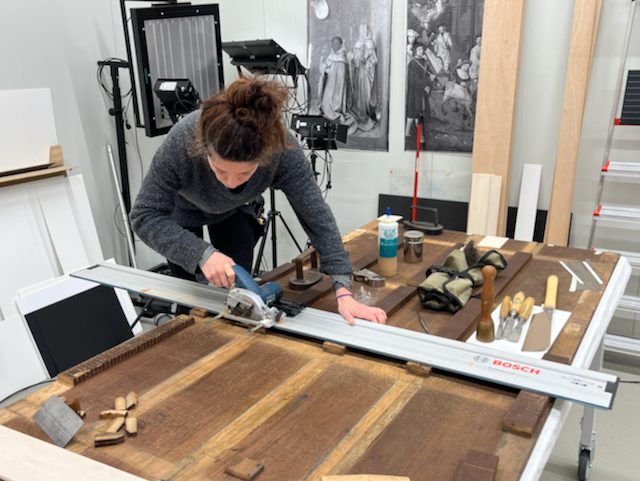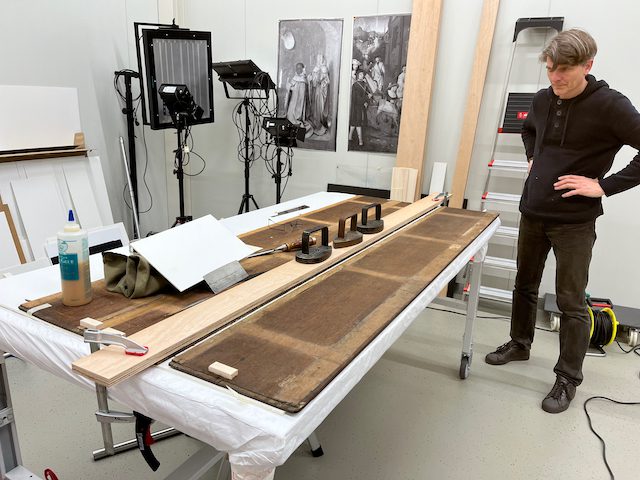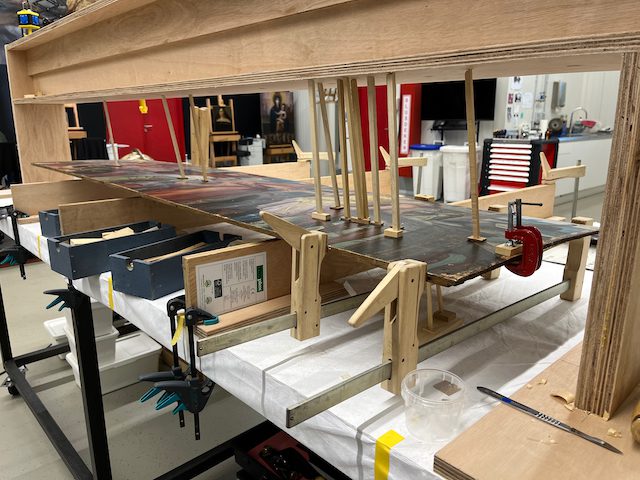Update: restoration panel Maarten De Vos
In an earlier article, we informed you about our treatment of the panel depicting the Apostle Peter with the centurion Cornelius (ca. 1560–1600), attributed to Maarten De Vos. This was a challenging treatment, because the painting was covered by layers of grime, old varnishes and overpaint, and the support was in poor condition. However, as is often the case, the oak panel was in poor condition. The boards showed multiple complex cracks, and the panel joints no longer aligned. Additionally, earlier restoration attempts had caused further damage to the wooden support. Therefore, the structure has been reinforced, and the panel will also be supported from the back.
The cleaning of the painting revealed a painted surface that was degraded by aggressive past treatments. It was also disfigured by stains due to chemical reactions in the paint. Luckily it preserved beautiful details as well: bright colours and the great quality of the portraits. But all in all, a structural treatment needed to take place.


Most structural issues of the painting derived from misguided past treatments and bad quality of the support. This had become reactive overtime and had warped. Woodworm and an original rigid framing had caused the first fractures and the disjoint of the bottom board before the damage caused the cradling of the painting. Cradling, a treatment not commonly used today, involves thinning the panel and attaching a rigid grid to the back to help support and straighten the painting. The panel rejected the cradle, causing it to partially come off and leading to severe cracks, flakes, and blisters in the paint layers. While further damage often happens with cradling, it’s usually not as dramatic as this.
Their job was to fix the panel and also address the issues that caused the damage. The goal was to restore its structure and improve the surface’s shape and level. With this in mind, Sara Mateu and Brian Richardson, along with Franziska Bunse, started the repair work earlier this summer.They removed the cradle and cleaned off the glue residue. Once they had a clear view of the back, they separated the boards that had come apart before. This let them clean the old glue left in the joints and cracks from past repairs.
Being the biggest panel ever treated in the studio, they built a custom-made gluing bridge – a temporary structure used in the conservation and repair of artworks – that could comfortably accommodate its size.

They started by fixing the smaller and easier fractures before tackling the more complicated damage. The panel had a serious compound fracture in an area affected by woodworm. These fractures are hard to repair because they go into the woodworm tunnels and come out somewhere else, making it hard to connect the damage seen on the front and back. Repairing some of these fractures needs a special technique that ensures a lasting fix but removes original material, so it’s only used for the worst cases.
The panel responded very well to a less invasive approach and they were able to treat all fractures and rejoin all boards with their standard approach. Despite being successful with the repairs, the panel remains weak and requires additional reinforcement.
The next step will be to create and attach a support to the back of the panel.